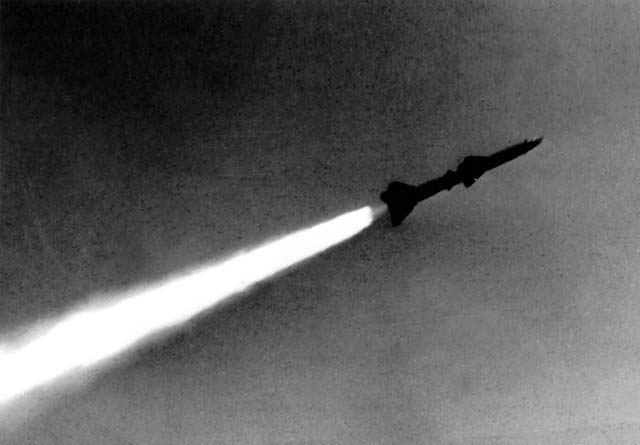 |
|||||||||
|
January/February 2014 Bill Milcarek & The Flash of the SAMs
BY RICHARD CURREY
Recalling that defining moment in a young Air Force officer’s life, Milcarek tapped memories going back forty years to the Christmas season of 1972, when an armada of B-52 bombers flew the most devastating aerial combat operation since the Second World War—Operation Linebacker II. “Just a couple years earlier I was a senior at Tulane University, had long hair, played in a rock band, and owned a couple of motorcycles,” Milcarek said. “I had no idea what was coming.” The draft lottery changed Bill Milcarek’s life—his number was nine, making it likely he would be drafted and sent to Vietnam. Milcarek graduated, joined the Air Force, and went through a “ninety-day wonder” program to become a lieutenant. “And, you know, I liked motorcycles, I liked speed, so it seemed like flying might be a fit.” By the time of Linebacker II, Milcarek was a captain and a B-52 co-pilot. On the night of December 27, 1972, he took off with his aircraft commander and crew from Andersen AFB in Guam to bomb a railyard outside Hanoi. Once over North Vietnam, the B-52 weathered near-constant surface-to-air missile attacks. Milcarek saw the launch-flashes of at least a hundred SAMs leave the ground, some fifteen of which came as close as two hundred feet to his aircraft. Linebacker II was in its ninth day and had already inflicted crushing damage to North Vietnam’s infrastructure in and around Haiphong and Hanoi. But the North Vietnamese government was still attempting to dictate terms to President Nixon. So Bill Milcarek and his crewmates were back in the air on December 29. Again they encountered a maze of SAMs. Then they picked up a MiG on their tail. Although North Vietnamese MiGs often served to track B-52s and radio their headings to SAM crews, a MiG could also down a B-52 with its own missiles. Milcarek and crew braced for such an attack when the MiG broke off and dropped away. They completed the bomb run without further incident. Back at Andersen AFB Milcarek and crewmates learned that Operation Linebacker II had ended. The political objective had been met: The North Vietnamese would negotiate. But the story wasn’t over for Bill Milcarek or his crewmates. They were ferried from Andersen to Utapao Royal Thai Airfield, a voyage of some 3,000 miles. Linebacker II might have ended, but bombing runs over North Vietnam continued. Their aircraft, call sign “Ruby Two,” took off from Utapao on the night of January 3, 1973. The mission: Hit a truck depot near the coastal city of Vinh. If the SAM barrages of Linebacker II were nightmarish, the ground defenses protecting Vinh were every bit as intense. Threading an aerial minefield, Ruby Two was less than a minute from bombs away when Milcarek saw four SAM launches off the left wing—two flashes, a brief delay, and then two more. The first two SAMs narrowly missed. Ruby Two was now ten seconds from the target. As the B-52 released its payload, it was rocked by a shattering explosion. “To help explain the experience of being hit by a SAM,” Milcarek said, “imagine you are in a giant light bulb that’s been thrown to the floor. A very loud pop, then a ringing in your ears which makes things very quiet for a few seconds.” Milcarek said there was no chaos after impact. “Everyone sounded calm. The benefit of all that training: We knew our processes, and we moved through them.” That training and reliance on mental checklists is also an antidote to fear, Milcarek said. “I was too concerned about procedures to have time to be scared.” The impact had crazed the cockpit windscreen, and the pilot handed control of the aircraft to Milcarek. “I had to fly visual formation because we had no flight instruments,” he said. “We only changed the radio frequency once for fear of causing an explosion from the fuel fumes emanating from the lower deck.” More SAMs passed in front of the B-52 and exploded somewhere above, concussions rocking the airplane. “Only two or three engine throttles remained connected,” Milcarek said. “All the others were severed. I was still flying the aircraft when we leveled out at 12,000 feet—bail-out altitude. I noticed the aircraft controls felt mushy, meaning we were nearing a stall. So I pushed up on all throttles and locked them in position and forgot about them.” Bail-out, or “punch-out,” was imminent. But the disabled B-52 was traveling too fast. Ejection at airspeeds greater than 400 knots could be fatal, but slowing to an air speed safe for bail-out might mean losing control of the aircraft. The single option was clear: Maintain air speed to keep control of the airplane, get to the punch-out point over the South China Sea, eject, and hope everyone makes it. The crew ejected, each in turn rocketing out into the cold night air. “We were all injured in various ways,” Milcarek said. “Some of us with fractured visors, all of us having neck strains or other injuries, and huge bruises between our thighs from the lanyard pull with the sudden and violent opening of our chutes.” Milcarek parachuted down in total darkness and deep quiet. “I didn’t know if I was blind or not. My visor was shattered. My face was covered with blood. I had blood in my eyes. I felt around, and it seemed like everything was in its place. Then I saw our B-52 explode in a massive fireball when it hit the water.” Then the sound of waves and wind, and Milcarek was in the water. A small observation plane spotted him bobbing in the fifteen-foot waves. But it would be four hours, well into the cold, hazy daybreak of January 4, 1973, before he and most of the crew were rescued by a chopper out of Da Nang. The men, bruised, bloody, waterlogged, and exhausted, were reunited at the hospital at Da Nang. Except, that is, for navigator Myles McTernan, affectionately known as “Mush.” “We were pretty solemn, thinking we’d lost Mush,” Milcarek said. There was a rush of relief when, several hours later, McTernan walked in. His ejection seat had failed, so he extricated himself and jumped through the hole left by another crewmember’s ejection seat. McTernan went out a few minutes after the rest of the crew—enough time to separate him from the group in the water. In a stroke of good fortune, a patrol boat spotted him. Not long after the events of January 3-4, the Strategic Air Command decided it was behind in upgrading a certain co-pilot. “Since I was the only B-52D co-pilot in SAC at the time, I was selected to enter the upgrade program,” Milcarek said. “After three months recovering from a bail-out neck injury and three months training in Thailand, I became the youngest aircraft commander in SAC.” Bill Milcarek left the Air Force in 1974. He wanted to become a commercial airline pilot, but was unable to find a slot. “I was married and had two small children and needed a job, so I became an insurance underwriter with Associated Aviation Underwriters,” he said. A year later Milcarek was back in the cockpit in the Air Force Reserves, flying C-5As out of Dover, Delaware, for the next three and a half years. Bill Milcarek retired from the Reserves as a Lt. Col. He has worked in aviation-related pursuits over the years, as well as in private security. Now 66, he lives in Manhattan, where he remains very involved in veterans affairs.
|
|||||||||
|
|
|||||||||
8719 Colesville Road, Suite 100, Silver Spring. MD 20910 | www.vva.org | contact us |
|||||||||










 “I saw the launch-flash of the SAMs,” Bill Milcarek said. “I watched from the time they left the ground all the way to impact with our aircraft.”
“I saw the launch-flash of the SAMs,” Bill Milcarek said. “I watched from the time they left the ground all the way to impact with our aircraft.”